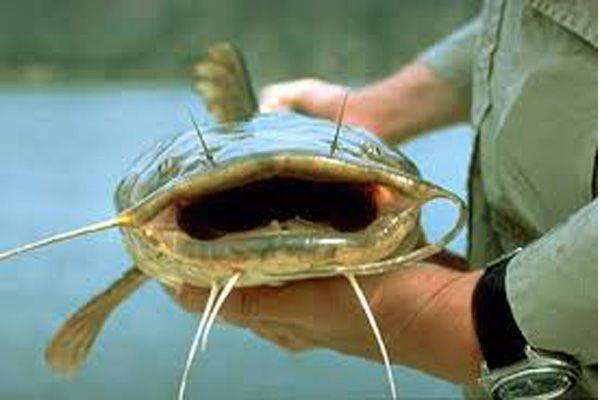By Dr. Doug Wakeman
[dropcap]Q[/dropcap]uiz: What do lionfish (and kudzu) in the southeast, lampreys in the Great Lakes, brown trout in the Appalachians, and stripers in San Francisco Bay have in common?
Answer: They are all non-native to those ecosystems, having been introduced either accidentally or intentionally. Another common element is, they’re difficult to get rid of once they become established. When mankind messes with an ecosystem, the mess tends to be permanent.
One difference among those non-natives is that people are mostly happy about the trout and the stripers, and not very happy with the others! And there’s a third category of non-natives where the reviews are mixed, as the introduced species has both benefits and costs. A recent example is spotted (Kentucky) bass in Carolinas lakes. Some people love to catch them, but others are concerned over the resultant loss of Smallmouth bass in those same systems. But whichever camp you fall in, it’s clear that the change is likely to be permanent.
Another entry in the mixed-reviews category is flathead catfish in the Apalachicola River: some people love ‘em, some people hate ‘em. Probably introduced in the 1970s in the Flint River (in Georgia, upstream), flatheads were confirmed and documented in the Apalachicola River by 1982. Since then, they have clearly thrived in the river, having spread in significant numbers (and compelling appetites) from the Woodruff Dam downstream to the Owl Creek area, or about 85 miles of river.
What’s less clear is the impact they have on the ecosystem. Flatheads are as hungry as they are prolific. Second in size only to the blue catfish — the current state record is over 55 pounds — they don’t get that big by being dainty eaters. Nearly every article you’ll ever read about flatheads (including this one!) calls them voracious predators. These are not mudcats lazily browsing the benthic organic ooze on the bottom. Flatheads are ambush feeders that devour just about any live fish that will fit in their huge mouths, including many kinds of bream (especially Redbreast sunfish), Largemouth bass, White bass, Striped bass, and other catfish (white, yellow, channel). They seem to have a particular fondness for the various bullheads. To date the scientific evidence is meager, but the anecdotal evidence has persuaded many observers: as the flathead population increases, fishing for other species tends to decline. If you’ve had trouble lately catching bream and bass at your usual spots in the upper half of the river, the flatheads just might be the reason why.
Like most non-natives, now that they are well-established, the flatheads are here to stay. Although some attempts were made in Georgia to reduce the flathead population via electrofishing, the results didn’t justify the expense, and such efforts seem unlikely to be repeated. So the only control of the population will be successful angling: catch all you want, and keep them.
Making the best of the situation, one ‘solution’ to the flathead problem is to have flathead catfish tournaments. Several organizations from Bristol, Blountstown, and Wewahitchka sponsor multiple tournaments each year. By all accounts, these have been rousing successes in all the ways that matter: money raised for local non-profits, fish caught & removed from the river, plenty of catfish stew for everybody, and good times had by all.
Angling for Flathead catfish isn’t for everybody: just how eager are you to tangle with 20-40 pound fish on a big, moving river, at night? If that’s to your liking, then flathead fishing is no great mystery: Live bait, stout lines, strong rods with strong & durable reels (some experts recommend grouper tackle), enough weight to keep your rig on the bottom (2-4 oz, depending on current), and live Bait. Did I mention live Bait? Remember, flatheads are predators rather than scavengers, so they’re likely to ignore anything that isn’t still breathing and swimming. Live bream as large as your hand seem to be the most frequent recommendation, although live shad are a reasonable second choice. Find places in the river where snags, eddies, and bottom irregularities create ambush opportunities for your quarry, get that live bream down to the bottom, and let the big predator become prey. Then, hold on and crank hard when the strike comes, as this is not a delicate operation!
Once back on shore, you now have a chore leading to an opportunity. Like other catfish, the flathead isn’t the easiest fish to clean and fillet, but there are plenty of experts (and videos) that can show you how to do it. Then, the fun begins! Flatheads may not push Maine Lobster off the menu at Chez Exorbitanté any time soon, but it’s often described as the best-tasting catfish around! Recipes abound for everything from huge stews (for that 50-pounder) to more delicate pecan-crusted oven-baked presentations, and everything in between. If you like to eat seafood, rest assured that there’s a flathead recipe out there that will make you happy.
At the end of the day, there are two morals to the story of Flathead catfish in the Apalachicola River. First, fooling around with Mother Nature is always subject to the Law of Unintended Consequences: introduction of non-native species rarely turns out the way people hope and plan, and the surprises are usually negative. Second, like ‘em or not, the flatheads are here to stay, so we might as well like ‘em: on the hook, at the weigh-in, and on the table. Bon appétit!
Doug Wakeman is Senior Policy Analyst for Apalachicola Riverkeeper, a member supported organization dedicated to the conservation and restoration of the Apalachicola River and Bay. Please send email to doug@ApalachicolaRiverkeeper.org, or visit us on the web at www.ApalachicolaRiverkeeper.org, or call us at 850-653-8936, or Find Us on Facebook.

